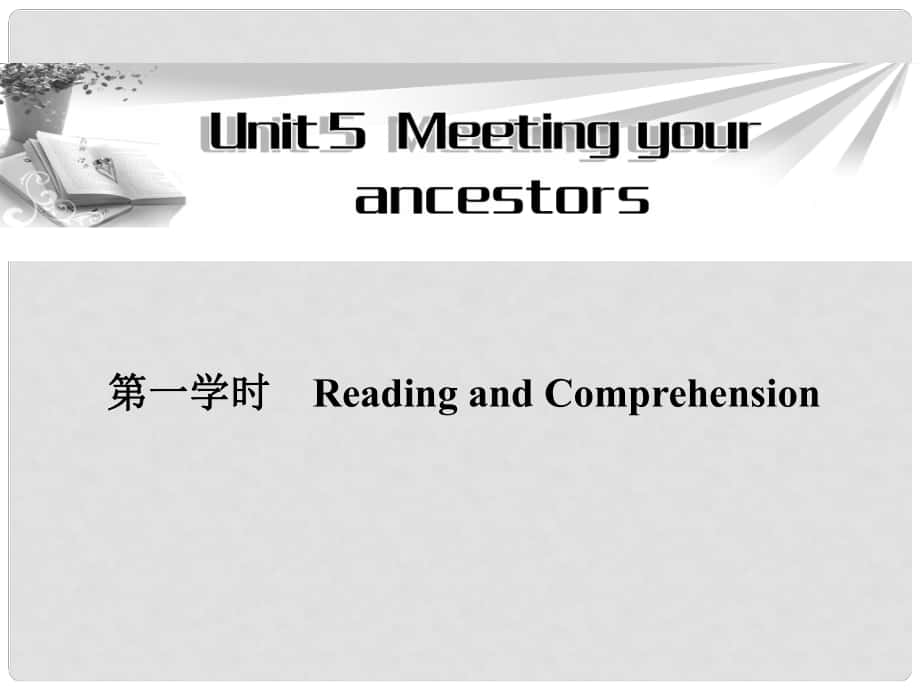《高中英語(yǔ) Unit5 第一學(xué)時(shí)Reading and Comprehension同步教學(xué)課件 新人教版選修8》由會(huì)員分享�,可在線閱讀�,更多相關(guān)《高中英語(yǔ) Unit5 第一學(xué)時(shí)Reading and Comprehension同步教學(xué)課件 新人教版選修8(23頁(yè)珍藏版)》請(qǐng)?jiān)谘b配圖網(wǎng)上搜索����。
1�����、第一學(xué)時(shí)第一學(xué)時(shí)Reading and Comprehension1Do you have anything in your home that was passed down from generation to generation? What are they and what was it made of?Yes. There are some old furniture which was made of wood like tables, chairs and a stone mill which was passed down by my ancestors.2. Do you
2、know anything about Peking Man ?It was discovered in Zhoukoudian, Longgu Mountain, Fangshan District, Beijing. It was listed as a World Cultural Heritage Site in 1987. In the 1920s archaeologist discovered a complete skull of an apeman dating back 600,000 years. It was later named Peking Man. Stone
3�����、tools and evidence of Peking Mans use of fire were found on the mountain.Task 1快速閱讀課文A visit to the ZhouKoudian caves,以約30詞寫(xiě)出文章的段落大意����。溫馨提示:本文是記敘文��, 寫(xiě)摘要時(shí)���,要緊扣人物、事件���、結(jié)果等要素�����。_A group of students from England came to visit the Zhoukoudian caves, from where they knew that the early people were clever enough t
4��、o make fire, clothes, necklace and there were even trade between them.Task 2仔細(xì)閱讀課文 A visit to The ZhouKoudian caves, 選擇正確答案。1Archaeologist guess there were people living in the Zhoukoudian caves because_. ( )Athey have found the bones of tigers and bears there Bthey have discovered a needle in the c
5���、aveCthey have found human and animals bones in those caves high up the hill as well as tools and ornamentsDThey have found the primitive necklaceC2The fireplaces in the center of the cave suggests that_. ( )APeking Man knew how to make fire to keep them warm, cook food and scare animals away, tooBPe
6、king Man knew how to make fireCPeking Man was very cleverDPeking Man used something to make fireA3The needle found in the cave indicates that Peking Man_. ( )Awas able to make tool at that timeBwas able to repair thingsCwas able to make clothes using animals skinsDAll are correct4The primitive neckl
7�、ace suggests that_. ( )Aearly people exchanged things with one anotherBearly people were clever enough to exchange thingsCthere was trade between peoplesDearly people always traded their things with othersDC5The main idea of the whole passage is _. ( )Aan archaeologist showed some objects to the stu
8�、dents from FranceBan archaeologist showed some students around the Zhoukoudian CavesCevidence of some of the earliest people living in the caveDtrade between early peoplesBTask 3再次閱讀課文����,完成下列表格�。HomesPeking man lived in Zhoukoudian Caves made of 1._,perhaps with2._to keep out the coldToolsThey used 3._
9�、that were made of 4._,sharpened stone tools and scraper made by stones.Dress They wore clothes from animal skins and they also wore necklace made from5._or animal teeth.1rocks and trees2.animal skins3.needles4.stones5seashells.Task 4根據(jù)課文A visit to the ZhouKoudian Caves在下文空格中填上恰當(dāng)?shù)脑~語(yǔ)�����,使文章連貫完整�����。A group o
10、f students from England has come to the Zhoukoudian Caves for a visit. An archaeologist _1_(show) them around. The archaeologists have been excavating here for many years._2_finding human and animal bones _3_those caves higher up the hill as well as tools and ornaments, they think it reasonable_4_ (
11���、assume) they lived in these caves, _5_the cold. They discovered fireplaces in the center of the caves _6_they constructed fires. Some evidence suggests that _7_ ancestors did wear clothes _8_(make) from animal skins. The archaeologist also shows the students a primitive necklace _9_ quite well. Inde
12�、ed, as the botanical analysis has been specially showing us, all the fields around here used to be part of a large shallow lake. Perhaps _10_ was trade between early peoples or they traveled to the seaside on their journeys.1. is showing2. After3. in4. to assume5. despite6. where7. our8. made9. pres
13、erved10. there 一、請(qǐng)將課文A visit to ZhouKoudian caves譯成漢語(yǔ)����,然后參考“譯文助讀”自主勘誤���。譯文助讀周口店洞穴參觀記一群英國(guó)學(xué)生(學(xué))來(lái)到周口店洞穴參觀�,有一位考古學(xué)家(考)正領(lǐng)著他們參觀�??迹簹g迎到中國(guó)來(lái)參觀周口店洞穴�。很高興見(jiàn)到你們這些來(lái)自英國(guó)并且對(duì)考古學(xué)感興趣的學(xué)生。你們想必都很清楚���,正是在這個(gè)地方���,我們找到了居住在世界上這個(gè)部分最早人類的證據(jù)。我們?cè)谶@兒進(jìn)行挖掘工作已經(jīng)很多年了����,而且學(xué)1:對(duì)不起,打斷了你的講話�。請(qǐng)問(wèn)他們?cè)趺茨軌蜃≡谶@個(gè)地方呢?這兒只有石頭和樹(shù)木啊����?����?迹?jiǎn)柕煤?。你是個(gè)敏銳的觀察者。在高山上的那些洞穴里我們找到了人骨和獸骨��,還
14�、有工具和其他物品。因此����,我們有理由認(rèn)為他們不顧嚴(yán)寒,就住在這些洞穴里��。學(xué)2:那他們是怎樣取暖的呢�?他們不可能像我們現(xiàn)在這樣有墊子、毯子和被子�。想必是很不舒服的了?����?迹何覀儼l(fā)現(xiàn)在洞穴中央有生火用的地爐。他們用地爐里的火來(lái)取暖�、做飯�����,還可以用火來(lái)嚇跑野獸���。我們一直在挖掘一層層的積灰,幾乎有六米厚��,這意味著他們可能整個(gè)冬天都在燒火�。我們還沒(méi)找到門(mén),但我們認(rèn)為在天寒地凍的冬季他們可能是用獸皮掛在洞口來(lái)防寒的��。學(xué)3:在那以前有些什么野獸呢����?考:嗯,我們?cè)诙蠢镪懤m(xù)發(fā)現(xiàn)了老虎和熊的骨頭��。我們認(rèn)為,這些野獸對(duì)他們來(lái)講是最危險(xiǎn)的敵人了?�,F(xiàn)在�����,你們看這個(gè)東西能告訴我有關(guān)早期人類生活的什么情況呢��?(指著一張畫(huà)有針線
15�����、的照片讓大家看)學(xué)2:哎呀����,那是一根針!天哪�,難道他們還會(huì)修補(bǔ)東西嗎?考:除此之外��,你認(rèn)為還可能派別的什么用場(chǎng)嗎����?學(xué)4:讓我看看。這個(gè)東西最多三厘米長(zhǎng)��,看起來(lái)像是用骨頭做的。我不知道他們是怎樣做成針眼的�����。學(xué)2:(插話)你是不是說(shuō)他們自己做衣服穿�����?他們又是從哪里搞到衣料的呢��?考:他們沒(méi)有像我們今天穿的這種衣料�����。你能猜出他們用的是什么嗎�?學(xué)1:哇��,他們穿的衣服全都是用獸皮做的嗎�?他們那些衣服是怎么做成的?獸皮剪裁并縫起來(lái)一定又厚又重啊���?�?迹何覀冇凶C據(jù)表明�,他們的確穿的是用獸皮制作的衣服。我們不斷發(fā)現(xiàn)一些磨削其他工具用的工具����。看樣子他們用磨尖的石器來(lái)切割野獸并剝皮�����,可能再用小一些的刮子把皮上的脂肪和
16����、肉去掉。然后他們可能在獸皮上擦上大量的鹽����,使皮變?nèi)彳洝W詈筮M(jìn)行剪裁���,縫起來(lái)就成了�。確實(shí)是既難又臟的活��!現(xiàn)在來(lái)看看這個(gè)吧��。(指著一串項(xiàng)鏈)學(xué)2:哎呀��!這是一條原始的項(xiàng)鏈吧。早期人類也像我們現(xiàn)在一樣講究外貌嗎���?太漂亮了��!考:是的����,還保存得很好呢�����。你們看看是用什么做的����?學(xué)4:我看看�。我想有的珠子是用獸骨做的,但是其他是用貝殼做的����,對(duì)嗎?考:你真聰明�����!有塊骨頭實(shí)際上是野獸的牙齒,貝殼是從海邊撿來(lái)的���。你還認(rèn)得別的骨頭嗎���?學(xué)1:這根很像魚(yú)骨頭,對(duì)嗎����?考:很對(duì)。植物學(xué)分析結(jié)果明確告訴我們�,這兒四周曾經(jīng)是一個(gè)很大的淺水湖。當(dāng)時(shí)可能湖里是有魚(yú)的���。學(xué)3:不過(guò)�����,湖并不是海呀���。我們離海還遠(yuǎn)著呢。那么���,貝殼又是怎么來(lái)的
17���、呢��?考:早期人類之間也許有貿(mào)易來(lái)往���,或者他們也可能旅行到海邊去。我們知道����,他們跟著獸群四處走。他們并不種植谷物����,而是在野果熟了的時(shí)候采摘它們并捕殺野獸來(lái)充饑��。這就是他們被稱之為獵人和采摘者的緣故�。好了,咱們現(xiàn)在去參觀洞穴好嗎�����?二�、請(qǐng)將下列詞語(yǔ)譯成英語(yǔ),然后參考Unit 5的詞匯表自主勘誤。1打斷講話�, 打岔 v. _2假定, 設(shè)想v. _3逮捕����, 吸引v. _4原始的,遠(yuǎn)古的adj. _1. interrupt2. assume3. arrest4. primitive5精確�, 準(zhǔn)確 n. _6鼓掌歡迎,贊賞v. _7追溯到 _8受夠了���, 飽受 _9不管���, 不顧 _10向前看, 為將來(lái)打算 _
18���、5. accuracy 6. applaud7. date back8. fed up with 9. regardless of10. look ahead三��、佳句背誦1. 想必你們知道�,正是在這兒我們找到了居住在世界這個(gè)部分的最早人類的證據(jù)�。You must_ that its here _ weve found evidence of some of the earliest people _ lived in this part of the world. 2. 他們用這火取暖、做飯����,還能用火嚇跑野獸����。That would have kept them warm, _ the food and scared wild beasts away _.3. 看樣子他們可能是用磨尖的石器來(lái)切割獸皮并剝皮�。_ they might have used the _ stone tools to_ animals and remove their skin. cut upbe awarethatwhocookedas wellIt seemed thatsharpened
 高中英語(yǔ) Unit5 第一學(xué)時(shí)Reading and Comprehension同步教學(xué)課件 新人教版選修8
高中英語(yǔ) Unit5 第一學(xué)時(shí)Reading and Comprehension同步教學(xué)課件 新人教版選修8

